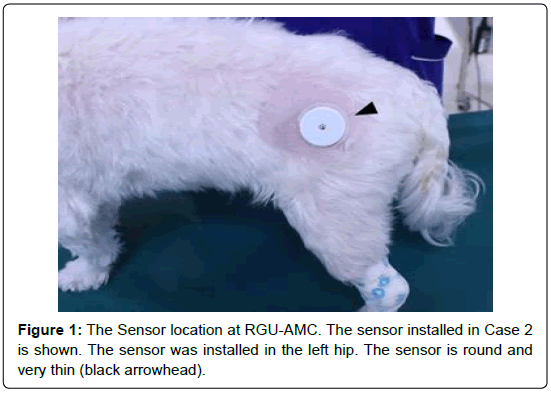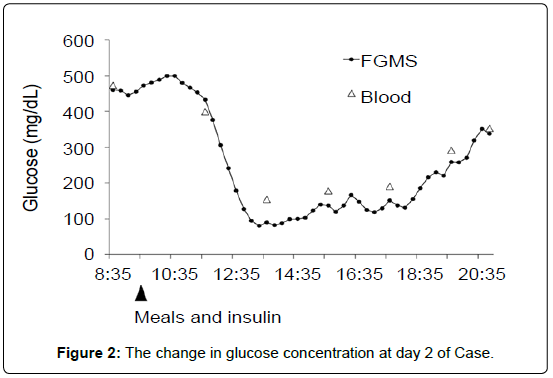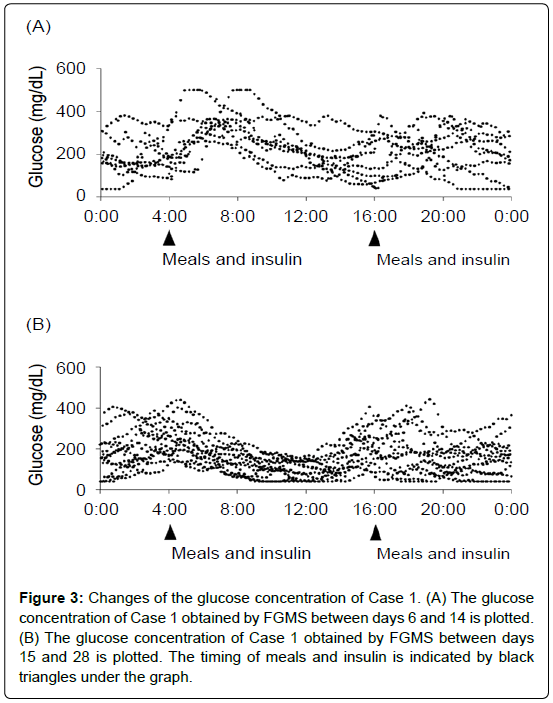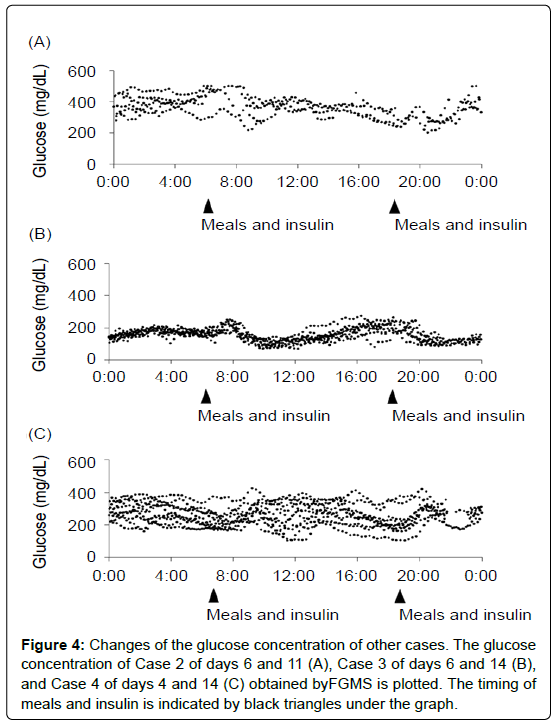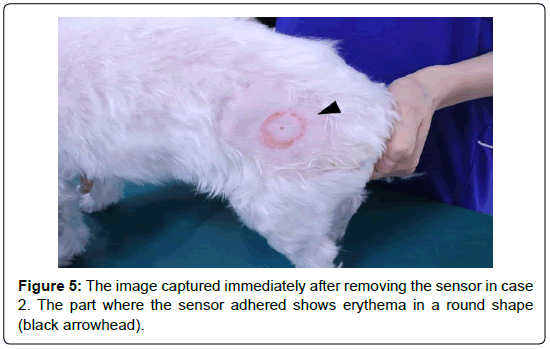Research Article, J Vet Sci Med Diagn Vol: 8 Issue: 3
Clinical Usefulness of Flash Glucose Monitoring System in Dogs with Diabetes Mellitus
Takashi Tamamoto1, Mizuki Kumano1, Hirotaka Igarashi2 and Tomohiro Yonezawa3*
1Laboratory of Veterinary Internal Medicine, Department of Small Animal Clinical Sciences, School of Veterinary Medicine, Rakuno Gakuen University, Ebetsu, Hokkaido, Japan
2Laboratory of Small Animal Internal Medicine, School of Veterinary Medicine, Azabu University, Sagamihara-shi, Kanagawa, Japan
3Department of Veterinary Clinical Pathology, Graduate School of Agricultural and Life Sciences, The University of Tokyo, Bunkyo-ku, Tokyo, Japan
*Corresponding Author: Tomohiro Yonezawa
Department of Veterinary Clinical Pathobiology, Graduate School of Agricultural and Life Sciences, The University of Tokyo, Bunkyo-ku, Tokyo 113-8657, Japan
E-mail: ayone@mail.ecc.u-tokyo.ac.jp
Received: January 28, 2019 Accepted: August 30, 2019 Published: September 05, 2019
Citation: Tamamoto T, Kumano M, Igarashi H, Yonezawa T (2019) Clinical Usefulness of Flash Glucose Monitoring System in Dogs with Diabetes Mellitus. J Vet Sci Med Diagn 8:3.
Abstract
A new flash glucose monitoring system (FGMS) for human has been developed recently. In the FGMS, glucose concentration in the interstitial fluid is measured for 14 days continuously by inserting a dedicated sensor subcutaneously. Although it is a device developed for human medicine, it has been reported that it can be used to measure glucose concentrations in dogs as well. The purpose of this study was to summarize the course of use of FGMS in dogs diagnosed with diabetes mellitus (DM). Four dogs diagnosed with DM were included in this study. For each case, the start of the trial was done under hospitalization, and a sensor was installed during hospitalization. In addition to the use of FGMS, blood samples were collected for measurement of blood glucose levels. The glucose concentration in the blood was compared with that in the interstitial fluid measured by FGMS. All cases were discharged with sensors installed, and measurement by FGMS was continued at home. There was a very strong correlation between blood glucose level and glucose concentration measured by FGMS. In 2 of the 4 cases, insulin dosage was changed based on the results of FGMS, which led to stable blood glucose control. In the remaining 2 cases, FGMS confirmed that blood glucose levels could be well controlled. Although further investigation is necessary for the installation location, the clinical usefulness of FGMS in dogs with DM was proven by this case series.
Keywords: Diabetes mellitus; Dog; Blood glucose levels; Diagnosis
Introduction
Diabetes mellitus (DM) is a common endocrine disorder in dogs. In the treatment of DM, it is important to know the blood glucose levels and its variations [1,2]. Usually, blood is drawn from the cephalic vein or the external saphenous vein, and the blood glucose concentration is measured using a blood biochemical measuring instrument. Measurement of blood glucose level is performed every several hours before and after meals and insulin administration, and the results are graphed. Thus, it is possible to know the effect of insulin, the time until the effect of insulin is obtained, and the duration of the effect. Since frequent blood sampling is necessary, drawing a graph of blood glucose level is generally performed under hospitalization. Although blood glucose measuring instruments that perform measurements with a small amount of blood obtained by puncturing fingertips or ears are sometimes used, they are still not popular in veterinary medicine [3].
Several problems exist in blood glucose level management under hospitalization [2]. It is impossible to completely follow the owner’s lifestyle, and the timing of insulin administration and meals at the hospital is not the same as that at home [3]. Depending on the nature of the animal, it may not be enough to eat a meal under hospitalization. In addition, animals under hospitalization are under stress, and there is a possibility that blood glucose levels may be affected. Thus, the changes in blood glucose levels at home should be known in detail.
A new flash glucose monitoring system (FGMS) has been developed recently [4-7]. In the FGMS, glucose concentration in the interstitial fluid is measured by inserting a dedicated sensor subcutaneously. This sensor can measure the glucose concentration automatically every 15 minutes while confirming the measured value each time by holding a dedicated reader. Moreover, by connecting the reader to the personal computer with a USB cable, it is possible to analyze the variation of the glucose concentration in detail. The sensor can be used continuously for 14 consecutive days after installation, and calibration by blood glucose level is unnecessary during that period [7]. Although it is a device developed and released for human medicine [4,6,8], it has been reported that it can be installed in dogs to measure their glucose levels [5]. The purpose of this study was to summarize the course of use of FGMS in dogs diagnosed with DM and to clarify its clinical usefulness.
Materials and Methods
Four dogs diagnosed with DM were included in this study. DM was diagnosed in each case based on complete blood count, blood biochemical examination, urine examination, and diagnostic imaging. Two dogs were diagnosed and treated at Rakuno Gakuen University Animal Medical Center (RGU-AMC) and two others were at Veterinary Medical Center of the University of Tokyo (VMC-UT). Because all dogs were client-owned, we provided sufficient information to obtain informed consent on a study that is still in the research stage. The placement of sensors in dogs already has precedent, and it has been reported that there were no serious troubles such as infection [5]. Based on that point, this study was conducted with the consent of the owners. The Animal Care and Use Committee of Rakuno Gakuen University approved this study (approved No.:VH16B15).
FreeStyle Libre (Abbott Laboratories, Lake Bluff, IL) was used as FGMS [5,6]. FreeStyle Libre consists of a sensor and a reader to read its measurement. The sensor has a circular shape measuring 35 mm × 5 mm, and a thin needle-like catheter protrudes from the center part. The catheter is inserted subcutaneously and the sensor is attached to the skin with adhesive tape. After installing the sensor, the sensor is activated by holding the reader. The device starts measuring glucose concentration automatically from 1 hour after startup, and continues to measure it every 15 minutes for 14 days. Furthermore, when the reader is held over the sensor, the glucose concentration at each time is displayed. Glucose concentration can be measured in the range between 40 and 500 mg/dL, and “LO” or “HI” are displayed if it is out of the measurement range. For each case, the start of the trial was done under hospitalization, and a sensor was installed during hospitalization. The sensor was installed after hair was shaved sufficiently and the skin was sterilized. The sensors were installed on the waist at RGU-AMC (Figures 1-5) and on the back at VMC-UT.
Figure 3: Changes of the glucose concentration of Case 1. (A) The glucose concentration of Case 1 obtained by FGMS between days 6 and 14 is plotted. (B) The glucose concentration of Case 1 obtained by FGMS between days 15 and 28 is plotted. The timing of meals and insulin is indicated by black triangles under the graph.
Black circle and solid line indicate interstitial fluid glucose concentration measured by FGMS and white triangles indicate blood glucose concentration. The timing of meals and insulin is indicated by black triangles under the graph. From the results of FGMS, it can be seen that the glucose concentration increased once after eating and then decreased.
Blood samples were collected to measure blood glucose levels and to compare the results with the levels in the interstitial fluid measured using the FGMS. Blood was extracted from the jugular vein, cephalic vein, or lateral saphenous vein, and was treated with the anticoagulant heparin. Plasma was collected after centrifugation and blood glucose concentrations were measured using a dry chemistry analyzer (FUJI DRI-CHEM 5000V; FUJIFILM Corporation, Tokyo, Japan). All dogs were discharged with sensors installed, and measurement by FGMS was continued at home. Data were collected at the next visit to the hospitals, and the sensors were removed at that time.
Statistical analyses were performed using a statistical software package (JMP version 12.0.1; SAS Institute, Cary, NC). Spearman’s rank correlation coefficient was used for comparison of blood glucose concentration and glucose concentration measured by FGMS.
Results and Discussion
Clinical information regarding body weight, intercurrent illness, and drugs being administered is summarized in Table 1. Pair samples of blood glucose concentration and glucose concentration in FGMS was obtained at 49 time points during hospitalization in all 4 cases. A significantly strong correlation was observed in the comparison of the respective measurement results (ρ=0.98, p<0.001).
Table 1: Summary of body weight, intercurrent illness, and drugs being administered.
| Case | Body weight (Kg) | Intercurrent illness | Drugs |
|---|---|---|---|
| 1 | 7.3 | PDHa | Trilostane 8 mg/kg/day |
| 2 | 4.6 | PDH, PLEb | Trilostane 3 mg/kg/day |
| 3 | 6.4 | MDSc, Pnacreatitis | Prednisolone 1.1 mg/kg/day, |
| 4 | 9.7 | Pancreatitis | None |
Note: aPDH: Pituitary-Dependent Hyperadrenocorticism
bPLE: Protein Losing Enteropathy
cMDS: Myelodysplastic Syndrome
Case 1
A 9 years old altered female Cavalier King Charles Spaniel was diagnosed with pituitary-dependent hyperadrenocorticism (PDH), DM secondary to PDH, and cataract secondary to DM at RGUAMC. As the cataracts worsened, she was scheduled to undergo a surgery; at that time, we decided to restart blood glucose control. Surgery was performed on day 1 and a sensor was set on the night after the surgery. NPH insulin (Humulin N, Eli Lilly Japan, Kobe, Japan) was started 9 units/head in the morning and 8 units/head in the night from day 2. The changes in blood glucose levels and glucose concentrations obtained with FGMS on day 2 are shown in Figure 2. Although both results are generally in agreement, measurement of blood glucose level every 2 hours has not captured an increase in glucose level immediately after meals. She was discharged on day 5, and then FGMS was used to measure glucose levels at home until day 14. Figure 3A shows the plot of the glucose concentration obtained by FGMS from days 6 to 13. Meals and insulin administration were conducted every day at around 4 AM and 4 PM. As shown in Figure 3A, there was a large variation in glucose levels in this case. Glucose concentration is elevated 2 to 4 hours after meals. On the other hand, the glucose concentration is often low at 4 to 8 hours after insulin administration. The general condition was good and clinical symptoms associated with DM such as polydipsia or polyuria were not observed at day 14. Body weight did not decrease compared to the weight at discharge.
However, we determined that glycemic control was not good based on the graph obtained by FGMS. Thus, we changed the insulin to a formulation in which NPH insulin and regular insulin were mixed at a ratio of 7:3 (Humulin 3/7, Eli Lilly Japan). The dosage of insulin was left unchanged. The sensor was replaced with a new one, and further measurement was performed using FGMS at home for 14 days. Figure 3B shows the plot of the glucose concentration obtained by FGMS from days 15 to 28. It was shown that the variation of the points decreased and the fluctuation of the glucose concentration became constant.
Case 2
A 10 years old castrated male Maltese was diagnosed with PDH and protein losing enteropathy (PLE) at RGU-AMC. During treatment, he showed polydipsia/polyuria and weight loss, and was diagnosed with DM. He was hospitalized from day 1 and a sensor was installed. NPH insulin (Humulin N, Eli Lilly Japan) was started at 4 units/head both in the morning and at night. However, because the effect was somewhat stronger, the insulin dosage was reduced to 3 units/head from day 4. He was discharged on day 5, and then FGMS was used to continue measurements at home until day 11. Figure 4A shows the plot of the glucose concentration obtained by FGMS from days 6 to 11. Overall, the glucose concentration showed high values, and it was found that the fluctuation range is small. Since the dog’s body weight was reduced at day 11 compared to when discharged, the dose of insulin was increased to 4 units/head. Subsequently, blood glucose control was good until he died on day 151 due to worsening of PLE.
Case 3
An 11 years old male Toy Poodle was diagnosed with myelodysplastic syndrome (MDS) two years prior to consult at our clinic and treated with a corticosteroid and immunosuppressant. He was diagnosed with pancreatitis and DM during the consultation at VMC-UT with chief complaints of vomiting. He was hospitalized from day 1, and insulin detemir (Levemir, Novo Nordisk Pharma Ltd., Tokyo, Japan) was started 0.5 units/head both in the morning and at night [9]. The sensor was installed on day 3. On day 5, pancreatitis improved and he was discharged because of good glycemic control. After that, measurement of glucose concentration by FGMS was continued at home until day 14. Figure 4B shows the plot of the glucose concentration obtained by FGMS from days 6 to 14. Glucose concentration has been in the range of approximately 100-200 mg/dL and variation is small. It can be observed that blood glucose control is good.
Case 4
A 9 years old male Miniature Schnauzer was brought for consultation with a doctor mainly due to vomiting and anorexia, and a high blood glucose level was observed. He was brought to VMCUT for consultation and was diagnosed with pancreatitis and DM. He was hospitalized from day 1, and insulin in which NPH insulin and regular insulin were mixed at a ratio of 7:3 (Novolin 30R, Novo Nordisk Pharma Ltd.) was started at the dosage of 5 units/head both in the morning and at night. The sensor was installed on day 1. On day 3, he was discharged because his appetite was sufficiently recovered and his blood glucose control was good. After that, measurements of glucose concentration by FGMS were continued at home until day 14. Figure 4C shows the plot of the glucose concentration obtained by FGMS from days 4 to 14. The insulin dose after returning home was changed daily from 1 unit/head to 5 units/head based on the glucose concentration obtained by FGMS. Although the glucose concentration was in the range of approximately 200-400 mg/dl, it had a large variation and the fluctuation of the glucose levels was not constant. Thereafter, the dose of insulin was fixed at 5 units/head and maintained well.
After sensor installation, pruritus was observed in 2 of 4 cases (Cases 1 and 2). In Case 2, the dog was bothered by the pruritus and chewed on the sensor, making measurement impossible.Therefore, we installed the sensor again on day 3. In addition, erythema was observed in all 4 cases when the sensor was removed (Figure 5). By talking to the owners afterwards, it was found that erythema improved in a few days. Although a needle was inserted under the skin during the installation of the sensor, pain at that time was not recognized. Pain and infection during and after sensor installation were not observed in all cases. The impression of owner was also good in general, and the sensors appeared to be acceptable to the dogs.
In this case series, FreeStyle Libre was used as FGMS in 4 dogs diagnosed to have DM. Each dog in this study also had hyperadrenocorticism or pancreatitis. In Case 3, corticosteroids were administered for the treatment of complications. In general, insulin resistance increases in these situations; it is often difficult to control glycemia with complications compared to glycemia in DM alone [10,11]. However, by using FGMS in combination with measurement of blood sugar level, blood glucose levels could be controlled smoothly.
One of the advantages of FreeStyle Libre is the ease of installation and measurement. Since installation itself is done with the applicator attached to the device, it is very simple [5]. For installation, a relatively flat part of the sensor diameter (about 35 mm) is chosen. It is necessary to cut the hair in the area sufficiently and to bring the sensor into close contact with the skin with the adhesive tape so that the inserted catheter does not shift. In a previous report, the sensor was installed in the neck [5]. In that report, the median weight of the dogs was 18.0 kg (5.4-43.0 kg). In this study, the weight range was 4.6- 9.7 kg, and it was difficult to secure the area required for installation in the neck. In addition, the dog in Case 2 was considerably thin due to other diseases, and it was difficult for the sensor to be installed in the neck. When installing the sensor, it is necessary to carefully choose the place considering the physique and the form of the animal. A report using another sustained glucose monitor describes the difference in measured value depending on the installation site [12]. In this study, the values obtained by the sensor correlated well with the blood glucose level even when placed on the lumbar region or back, and there was no clinical difference. However, regarding the installation site and installation method, it is thought that further examination is necessary based on the weight and physique of the dog.
For installation, the catheter is inserted under the skin with the needle as a guide. The pain experienced by the dogs during installation was not clear in this study [13]. Although pruritus may be observed during installation or immediately after removal, it was acceptable. The owners were interviewed, but no marked discomfort or pain was observed in the dogs at home. As the adhesive tape was used, erythema was found in all cases when the sensor was removed. This has been confirmed in a previous report as well [5]. Similar pruritus and erythema were also reported in humans [14]. However, it did not last for a long time and disappeared in about 24 hours. Even in this study, the owners reported that there was no major problem in follow-up investigations.
The glucose concentration measured by FGMS and blood glucose level correlated well. Even in a previous report, a high correlation (ρ=0.94) was reported [5], and nearly equivalent results were obtained. In this study, dogs with various complications such as PDH, PLE, and pancreatitis were included. However, the measurement results did not see affected by the complications. Fluctuations in glucose concentration are thought to be more complicated when there are complications, and FGMS would be effective.
All four dogs were discharged with sensors installed, and measurement by FGMS was continued at home. The recorded data of sensor are overwritten in 8 hours; thus, we needed to read the data at least every 8 hours. We asked owners to do the reading using the reader at home, and it was possible to do so without difficulties. It is a great advantage that we can easily measure by just holding the reader [13]. In addition, it is fairly advantageous to be able to automatically record nighttime data, which is usually difficult to implement [14].
It is also meaningful to be able to visualize not only fluctuations in one day but also changes in one to two weeks. Both Case 3 and Case 4 showed good progress after discharge, but the graph shows that Case 3 was stable while Case 4 had large variability. It is expected that this difference can be utilized for treatment. Indeed, in Case 1 and Case 2, insulin dosage was changed based on the results of FGMS, and blood glucose control was stabilized by these changes. Case 1 shows hyperglycemia especially after eating, and Case 2 had high glucose concentration in general. Although it is possible to detect hyperglycemia from the past two weeks by fructosamine or glycated albumin [15,16], it is not known at what timing the blood glucose level will rise. By using FGMS, it can be determined whether the glucose concentration is continuously high or whether it rises rapidly after a meal. However, the measurement of fructosamine or glycated albumin was not done in this study, and it is not possible to compare.
The measurement range of FreeStyle Libre is between 40 and 500 mg/dL, and notable hyperglycemia and hypoglycemia cannot be measured. In dogs with DM, blood glucose levels often exceed 500 mg/dL immediately after the start of treatment. Thus, it may be hard to use at that time. It has been reported that the measurement of blood glucose level and FGMS have a slightly larger error when the subject is hypoglycemic [5]. Although no symptoms due to hypoglycemia were observed in this study, the measurement was less than 40 mg/dL at multiple time points. It is necessary to study the relationship with hypoglycemia in detail.
Conclusion
Good results were obtained using FGMS for dogs with DM. Although it is necessary to study the attachment site further, clinical usefulness is considered high because it can be easily installed and measured, it can obtain data continuously even at night, and it can be easily used even at home. The duration is as long as 14 days, and the advantage of being able to check the fluctuation at the interval of 1 week to 2 weeks is also great. Because the device is also relatively inexpensive, it is expected to greatly contribute to the treatment of diabetes in veterinary patients.
Acknowledgements
We deeply appreciate the dogs and their owners who cooperated in the research.
References
- Behrend E, Holford A, Lathan P, Rucinsky R, Schulman R (2018) AAHA Diabetes management guidelines for dogs and cats. J Am Anim Hosp Assoc 54: 1-21.
- Cook AK (2012) Monitoring methods for dogs and cats with diabetes mellitus. J Diabetes Sci Technol 6: 491-495.
- Aptekmann KP, Armstrong J, Coradini M, Rand J (2014) Owner experiences in treating dogs and cats diagnosed with diabetes mellitus in the United States S. J Am Anim Hosp Assoc 50: 247-253.
- Bailey T, Bode BW, Christiansen MP, Klaff LJ, Alva S (2015) The performance and usability of a factory-calibrated flash glucose monitoring system. Diabetes Technol Ther 17: 787-794.
- Corradini S, Pilosio B, Dondi F, Linari G, Testa S, et al. (2016) Accuracy of a flash glucose monitoring system in diabetic dogs. J Vet Intern Med 30: 983-988.
- Fokkert MJ, Dijk VPR, Edens MA, Abbes S, De Jong D, et al. (2017) Performance of the freestyle libre flash glucose monitoring system in patients with type 1 and 2 diabetes mellitus. Diabetes Res Care 5: 1-8.
- Hellmund R, Weitgasser R, Blissett D (2018) Cost calculation for a flash glucose monitoring system for UK adults with type 1 diabetes mellitus receiving intensive insulin treatment. Diabetes Res Clin Pract 138: 193-200.
- Olafsdottir AF, Attvall S, Sandgren U, Dahlqvist S, Pivodic A, et al. (2017) A clinical trial of the accuracy and treatment experience of the flash glucose monitor freestyle libre in adults with type 1 diabetes. Diabetes Technol Ther 19: 164-172.
- Fracassi F, Corradini S, Hafner M, Boretti FS, Sieber-Ruckstuhl NS, et al. (2015) Detemir insulin for the treatment of diabetes mellitus in dogs. J Am Vet Med Assoc 247: 73-78.
- Davison LJ (2015) Diabetes mellitus and pancreatitis-cause or effect? J Small Anim Pract 56: 50-59.
- Miceli DD, Pignataro OP, Castillo VA (2017) Concurrent hyperadrenocorticism and diabetes mellitus in dogs. Res Vet Sci Elsevier 115: 425-431.
- Koenig A, Hoenig ME, Jimenez DA (2016) Effect of sensor location in dogs on performance of an interstitial glucose monitor. Am J Vet Res 77: 8050-817.
- Alsaffar H, Turner L, Yung Z, Didi M, Senniappan S (2018) Continuous flash glucose monitoring in children with congenital hyperinsulinism ; first report on accuracy and patient experience. Int J Pediatr Endocrinol 3: 4-9.
- Mori A, Kurishima M, Oda H, Saeki K, Arai T, et al. (2013) Comparison of glucose fluctuations between day- and night-time measured using a continuous glucose monitoring system in diabetic dogs. J Vet Med Sci 75: 113-117.
- Sako T, Mori A, Lee P, Takahashi T, Izawa T, et al. (2008) Diagnostic significance of serum glycated albumin in diabetic dogs. J Vet Diagnostic Investig 638: 634-638.
- Sako T, Mori A, Lee P, Sato T, Mizutani H, et al. (2009) Serum glycated albumin: Potential use as an index of glycemic control in diabetic dogs. Vet Res Commun 33: 473-479.
 Spanish
Spanish  Chinese
Chinese  Russian
Russian  German
German  French
French  Japanese
Japanese  Portuguese
Portuguese  Hindi
Hindi 